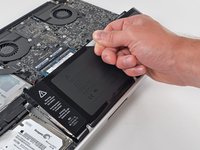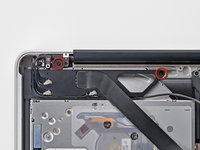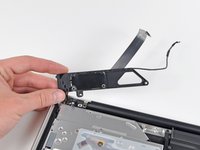crwdns2915892:0crwdne2915892:0
There are many benefits to adding a second hard drive to your laptop such as improved speeds, greater storage space, and less heartache when installing new software. Use this guide to install one using our optical bay hard drive enclosure.
crwdns2942213:0crwdne2942213:0
-
-
Remove the following ten screws securing the lower case to the upper case:
-
Three 13.5 mm (14.1 mm) Phillips screws.
-
Seven 3 mm Phillips screws.
-
-
-
Using both hands, lift the lower case near the vent to pop it off two clips securing it to the upper case.
-
Remove the lower case and set it aside.
-
-
-
Remove the two 7.4 mm Tri-point screws securing the battery to the upper case.
-
Note: For certain repairs (e.g. hard drive), removing the battery is not necessary but it prevents any accidental shorting of electronics on the motherboard. If you do not remove the battery, please be careful as parts of the motherboard might be electrified.
-
-
-
Use the tip of your finger to carefully peel back the corner of the warning label to reveal a hidden Tri-point screw.
-
Remove the last 7.4 mm Tri-point screw securing the battery to the upper case.
-
-
-
Lift the battery by its plastic pull tab and slide it away from the long edge of the upper case.
-
-
-
Tilt the battery away from the logic board enough to access the battery cable connector.
-
Pull the battery cable connector away from its socket on the logic board and remove the battery from the upper case.
-
Charge it to 100%, and then keep charging it for at least 2 more hours. Next, unplug and use it normally to drain the battery. When you see the low battery warning, save your work, and keep your laptop on until it goes to sleep due to low battery. Wait at least 5 hours, then charge your laptop uninterrupted to 100%.
-
If you notice any unusual behavior or problems after installing your new battery, you may need to reset your MacBook's SMC.
-
-
-
Use the flat end of a spudger to pry the AirPort/Bluetooth ribbon cable connector up off the logic board.
-
-
-
-
Disconnect the camera cable by pulling its connector away from the socket (toward the optical drive) on the logic board.
-
-
-
Use the flat end of a spudger to pry the optical drive connector up off the logic board.
-
-
-
Remove the two Phillips screws securing the AirPort/Bluetooth board housing.
-
Carefully rotate the AirPort/Bluetooth board housing (with AirPort/Antenna cables still attached) out of the lower case.
-
-
-
Remove the following three Phillips screws securing the optical drive to the upper case:
-
One 4.5 mm Phillips screw securing the optical drive bracket to the upper case near the fan.
-
Two 2.5 mm Phillips screws securing the optical drive to the upper case near the optical drive opening.
-
-
-
Lift the optical drive near its connector and pull it away from the upper case to remove it from the computer.
-
-
-
Pull the optical drive cable out of the optical drive.
-
Optical drive remains.
-
-
-
Remove the two black Phillips #0 screws securing the small metal mounting bracket. Transfer this bracket to your new optical drive or hard drive enclosure.
-
-
-
Remove the plastic spacer from the optical bay hard drive enclosure by pressing in on one of the clips on either side and lifting it up and out of the enclosure.
-
-
-
Make sure that the hard drive connectors are facing down before placing it into the enclosure.
-
Gently place the hard drive into the enclosure's hard drive slot.
-
While firmly holding the enclosure in place with one hand, use your other hand to press the hard drive into the enclosure connectors.
-
-
-
Once the hard drive is snug, reinsert the plastic spacer while holding the hard drive against the bottom of the enclosure.
-
-
-
Use two Phillips #1 screws to secure the drive to its enclosure.
-
-
-
Attach the optical drive bracket to the new enclosure with two Phillips #0 screws.
-
Reconnect any cables you have removed from the original optical drive onto the optical bay enclosure.
-
-
-
Align the cable's SATA connector with the drive's port and plug in securely.
-
Plug the USB connector into your laptop and your optical drive is ready for use.
-
To reassemble your device, follow these instructions in reverse order.
To reassemble your device, follow these instructions in reverse order.
crwdns2935221:0crwdne2935221:0
crwdns2935229:0132crwdne2935229:0
crwdns2947412:07crwdne2947412:0
Step 8: The cable needs quite a hard pull to come out, be careful to pull straight! When reconnecting I used 2 wooden sate stick to push the connector back in.
Now running an sad for startup and the old HD as capacity storage. Thanks for the great manual on how to do these!
After finishing this guide, it occurred to me to test out a little known feature in MacBooks...
The MacBook has sensors that detect motion. When the sensors detect motion that is violent enough to risk damaging the spinning hard drive (and it doesn't have to be much), the head gets temporarily disengaged from the disk so that the risk of damage decreases. If you ever pick up your laptop quickly and hear a click, that is what is happening.
After installing a hard drive where the computer only ever expected an optical drive, that safety feature is lost. Now when I pick up my MacBook when the drive is spinning, there is no click. I put an SSD in place of the old drive, so I can't confirm if it still works in the actual hard drive area of the computer... but the one in the optical drive area definitely no longer can protect itself from rapid movement.
Still a fantastic upgrade, but remember to treat the hard drive in the optical bay as slightly more prone to failure than before.
The fact that we can still use the optical drive (step 20, now external) is nice, but I would like to put it into some enclosure/caddy/case as well instead of having it bare naked . Don't you sell anything for this?
Great instruction found it very useful and worked for me all the way. Thank you
Hi there,
I followed the guide without problems but weeks after that I am experiencing sudden reboots when there is a change in the Graphic card (even when using forcing programs as gfxCardStatus). After looking for many patches or updates, I think it may be a problem of the SSD (a Crucial BX100 250gb), but I wanted to ask you first if anyone have had this same problem and if there’s any recommendation before buying another SSD drive.














































